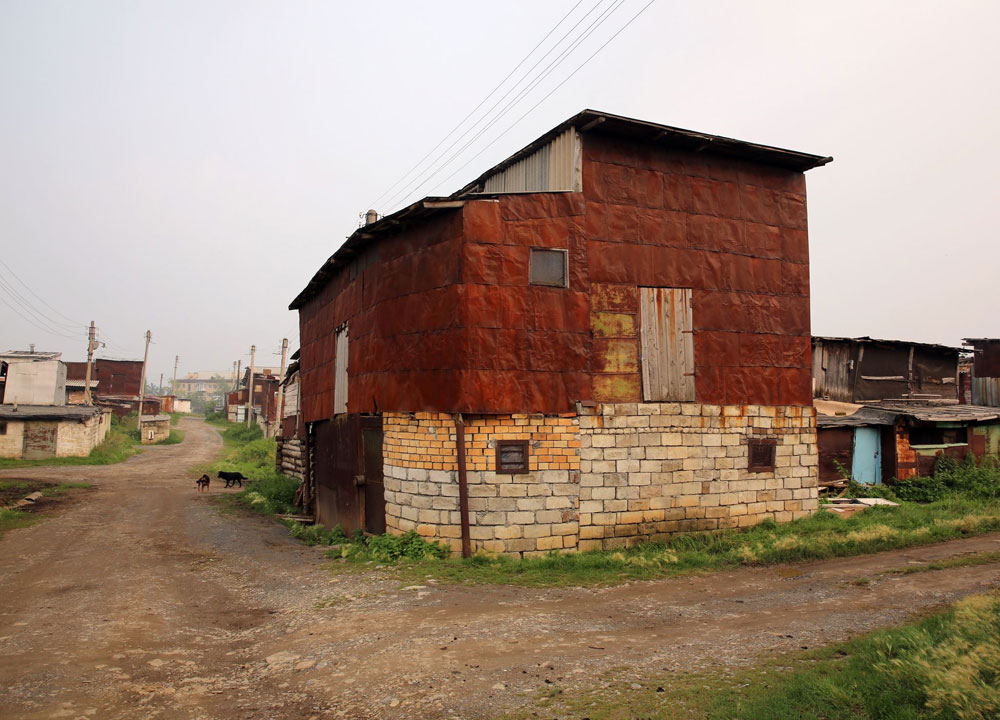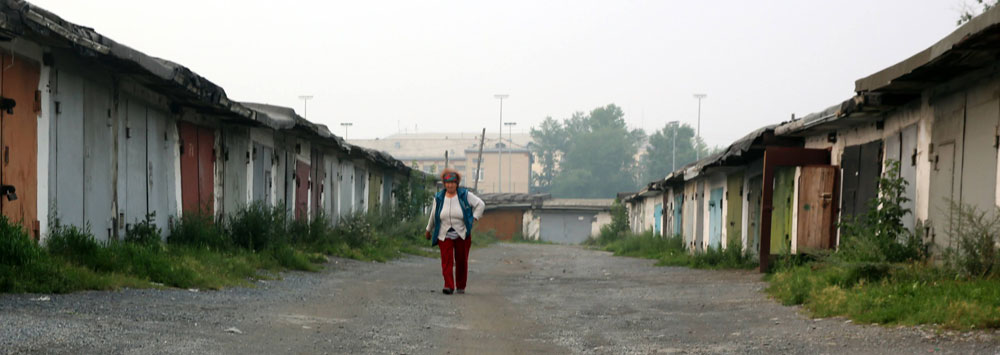Town meets country: how sheds explain modern Russian life

In the small towns of Russia, sheds and garages are more than just a handy storage space — they're a way of life. Philosopher Vitaly Kurennoj went, camera in hand, in search of their significance
“It’s cold early in the morning, but you still have to go to the pen before school. Grandma will cook a pot of feed for the pigs, and you take it there,” says Sergei who leads us along between the garages and sheds and tells us about his childhood in the late 1980s. “Because the feed is hot you can’t give it straight away, so you go to the water tank, add some water and only then can you give it to them.”

We are walking through one of the neighbourhoods in Satka, a small town in the Urals not far from Chelyabinsk. The neighbourhood consists of lots of small structures: garages, sheds and barns. You’ll find this odd block on a hill known as the Hammer and Sickle. The town’s main street, Proletarskaya, starts up here. It’s often referred to as Guest Street, because it’s normally what gets shown to out-of-town visitors. The hill acquired its name for a reason: it is topped by a giant steel hammer and sickle — something like a smaller version of Vera Mukhina’s Worker and Kolkhoz Woman in Moscow. But this impressive symbol doesn’t dominate views of the city, for the simple reason that it is surrounded by all these garages. Their roofs carpet the whole hill, giving the impression of a single grey mass. On the very top of the hill there are two helipads, but you would never know unless you wandered up there.

As we climbed the hill we asked about the garages. Our guides Sergei and Vasily corrected us: there are not only garages up here, but also what are called staiki. Staika is a common name for a sort of shed in the Urals, but here in Satka the name takes on an even more specific meaning: it’s where you keep livestock. Unlike a garage, a staika is a tall building, normally with a couple of stories above ground. These staiki first appeared, Sergei and Vasily told us, when migrants from the countryside, used to a self-sufficient lifestyle, moved into the nearby communal housing blocks. They brought their way of life with them — they might live in the city but just over the road are their animals in a staika.

Staiki, and the self-sufficient lifestyle which they represent, enjoyed a particular boom in the 1990s. In fact, after the collapse of the economy the whole country moved en masse toward this lifestyle. In Satka, people even formed a stock-raising collective, called Zarya (“Dawn”). The cooperative actually still formally exists — you can even find a sign for it among the labyrinth of staiki and garages. There are almost no animals left here, but in some places you do find heaps of dung, and at the top of the hill a few cows stroll around accompanied by contemplative shepherds.

On the outskirts of the garages you can still come across tattered signs promoting car repair services that seem to get very little custom. During the weekends blokes that are good with their hands can be seen building things in the garages. Cars are few and far in between. Better-off citizens prefer to keep theirs in guarded parking lots; the rest leave them near their houses in the city.

The garage is a huge fragment of Soviet culture that has survived in the modern-day Russian city. It is the most important element of a so-called dispersed way of life. Like the dacha, the garage divided the household between several living quarters. Simon Kordonsky, the academic who introduced this concept of the dispersed way of life, sees the garage and the dacha as secret storage spaces, places where you can accumulate different supplies to guard yourself against any possible government repressions. This theory based in repression is not necessarily inaccurate, but, to my mind, it is somewhat one-sided and exoticises garages as a phenomenon.

In my opinion, the dispersed economy is, in part, a product of the lifestyle of Soviet citizens who are still not completely urbanised. Although these citizens live in the city, they still keep up some of the practical aspects of village life, like allotments and — if they’re as lucky as the citizens of Satka — staiki with livestock or chickens, all within easy reach of their city home. This was a very useful and sensible solution in a Soviet economy typified by scarcity. What’s more, sheds, garages and staiki are also an entirely sensible insurance against more recent and more sporadic economic calamities, such as the complete collapse of the farming industry at the beginning of the 1990s. In their garage a good homemaker will also have a cellar in which the shelves are stacked with pickles and jams and, if proper heating is set up, potatoes are stored over the winter. These garages even bred their own forms of communication: new cooperatives emerged that generated their own distinctive forms of social capital. Here (above) one of them is building something in his garage. It has been turned into a proper office-cum-workshop; in the background you can catch a glimpse of a watercooler and some photo wallpaper.

Another aspect of the dispersed economy is the non-urban attitude to material possessions, a result of an underdeveloped culture of mass consumerism. Because of economic scarcity, old items are never thrown away or exchanged for new ones, but are stored, just in case. If necessary, they are remade to fit a new purpose. This culture still endures among the older generation. Until it is discarded completely, an item usually travels a long path. It is first sent to the dacha; if it breaks there — no problem, it can be moved to the shed, it might come in handy one day. After all, it’s better than wasting money on another rail or board. If you don’t have a dacha, a garage or shed in the city will do the job. On Hammer and Sickle Hill it turns out that some families have several garages. Vasily’s granddad keeps his car in one of them, in the traditional manner, to keep it from rusting. His other garage is devoted to storing old things, just in case. From all these things, a skilled handyman — what Claude Lévi-Strauss would call a bricoleur — could find the necessary materials to solve any number of urgent issues: repairs or improvised contraptions. In the 1990s this highly creditable approach flourished, and necessarily so. Actually, the various economic booms of recent decades have been reflected in the look of the garages: some were built with tall doors so that they could accommodate a Gazel — the most common Russian truck for small businesses.

The former uses of garages are slowly fading. Our young companions find it hard to say what their families do there — it is almost entirely a matter for the older generation. Staiki are reborn and remade. Many have fallen apart or have a collapsed roof, others have burned down. Here we see a tattered sofa and armchair on the street — these have been appropriated by enthusiasts of outdoor drinking. Through the slightly open door, you can just make out a homeless person’s back — one of the area’s new inhabitants.

This, as you can see immediately, is the home of Crazy Cat Lady from the Simpsons — another committed hoarder. She is chatting to her cats from behind the door.

This staika has become a home: on the second floor a housewife has cultivated an entire gallery of flowers. It belongs to one of the bosses of this slum quarter — a well-off scrap metal merchant.

A new slum is forming around the staiki and garages of the dispersed economy, its growth hampered only by the harsh climate of the Urals. It’s a slow process: forged during the turbulent 1990s, the steel doors of the garages and staiki are still holding together. Behind the concrete wall which separates the staiki from the street and runs along the hill, young families stroll along with pushchairs on a Saturday evening.

The slum doesn’t encroach on the city — the concrete wall makes sure of that. Instead it is creeping up the hill, towards the Hammer and Sickle. Apart from a few cows, the only regular visitors are Lada Nine cars with blacked out windows — the preferred transport of petty criminals. The doors swing open and loud music flows out into the fresh air. Then empty bottles fly out. One of the helipads is covered in broken glass; the other is clear, for now — it seems to have been cleaned for the visit of the governor. When he comes he will be taken down into the city along a different road, the one on other side of the hill: they wouldn’t want to ruin his impression of the town by exposing him to the staika-slum.
